On 1 October 1854 the rate by private ship or by packet between the UK and the Colonies of NSW, Victoria and South Australia was reduced to 6d for a half-ounce letter. Payment progression followed the usual British system: 2 rates to 1 oz, then another 2 rates per oz or part oz. This rate included all charges to destination in either country, and could be prepaid or unpaid at the discretion of the sender. The 6d all-in rate was extended to Tasmania in August 1855, and Western Australia from 1 July 1856. The packet rate was split into a penny to each country for inland, and 4d to the country paying for the packet. Each letter had to be accounted for and marked to show the sum due to, or from, the receiving country, giving rise to a series of so-called accountancy markings.
The UK chartered all the outbound and many of the homebound packets and so was usually entitled to 5d of the 6d rate, but on occasions Victoria made single voyage charters during the period; for these voyages Victoria was credited with the 4d sea postage plus the 1d colonial inland, the UK receiving 1d only. If sent via Marseilles the French transit rate of 5d per ¼oz was additional – such letters are extremely scarce as most of the packets, and nearly all private ships, went via the long sea route during the accountancy period. For private ships the 6d rate was divided equally – 3d to each country – and the accountancy markings were simple: 3d in black if sent unpaid, and 3d in red if sent paid.
Accountancy markings on single rate packet letters NOT via France, were thus as tabulated below. Double these sums for letters over ½oz and under 1oz, and quadruple for 1 to 2 ounce letters.
Prepaid letters from UK to Australia | 1d in red | Sum due to Colony for inland postage from the 6d prepaid by sender |
Unpaid letters from UK to Australia | 5d in black | Sum due to UK from Colony from the 6d collected from recipient |
Prepaid letters from Colony to UK by British packet | 5d in red | Sum due to UK from 6d prepaid by sender |
Prepaid letters from Colony to UK by Colonial packet | 1d in red | Sum due to UK from 6d prepaid by sender |
Unpaid letters from Colony to UK by British packet | 1d in black | Sum due to Colony from the 6d collected from recipient |
Unpaid letters from Colony to UK by Colonial packet | 5d in black | Sum due to Colony from the 6d collected from recipient |
There was only one packet voyage outbound via France during the accountancy period, being the last P&O service via Singapore. This mail left London on 9 Nov 1854 and arrived at Sydney on 18 Jan 1855. I have yet to see a cover, but prepaid mail should still have a 1d accountancy marking in red, for the sum due to the Colony; unpaid letters sent via Marseilles should have a 10d accountancy marking, 5d to UK for the inland plus packet fee, plus 5d to be paid to France by the UK for the exorbitant French transit fee. The recipient should have been charged 11d.
As far as I am aware at present only three homebound contract voyages occurred during the accountancy period that could have carried packet mail via France – these are tabulated below. The Madras being a British packet, accountancy markings should have been: 1d in black on unpaid letters, UK collecting 11d from the recipient and paying France 5d and the Colony 1d out of the proceeds; and 10d in red on prepaid letters, UK paying France 5d for transit fees out of this 10d, and retaining 5d for carriage by British packet. Both Blanche Moore and Formosa were colonial contracts, so accountancy markings should have been: on unpaid letters 5d in black, UK collecting 11d from the recipient and paying France 5d and the Colony 5d out of the proceeds; and 6d in red on prepaid letters, the colony retaining 5d of the 11d rate, the UK paying France 5d and retaining 1d for UK inland from the 6d credit. See Fig 8.
For ship letters (i.e. not by contract packet) the situation was relatively uncomplicated. Non-contract ships almost always went out via the Cape of Good Hope, and back via Cape Horn, so there was no complication for letters via France. On rare occasions a ship would leave Australia for Ceylon or other port on the P&O steamer route back to UK via Suez, but these were always charged by the UK as packet letters since that were delivered in UK by packet. For all practical purposes therefore prepaid ship letters had a red “3” accountancy marking for the sum due to the receiving country – see Fig 3; unpaid ship letters had a black “3” for the sum due to the despatching country.
Accounting for each letter individually was a great waste of manpower, so it was mutually agreed that, for the new 1857 steam service , all postage must be prepaid, and each country would keep the postage it collected. “All Letters and newspapers addressed to the Australian colonies, including Tasmania and New Zealand, posted on 13 January next, and thenceforward, will be forwarded (unless otherwise directed) via Suez by the new line of contract packets established to run once a month between this country and Australia, and will be liable to the following rates of postage”: 6d ½ oz via Southampton; 9d ¼ oz, 1/- ½ oz, 1/9d ¾ oz, 2/- oz via Marseilles. Letters not to be forwarded unless postage is prepaid, postage to be taken to indicate the route required. This Notice also encompassed the reduced French transit rate of 3d per ¼ oz introduced under the 1857 Anglo-French Postal Convention. South Australia refused to contribute to the new steam service, as the route did not include a call off Adelaide, and for a time tried to perpetuate the accountancy period – for an example see Figure 9.
Thus the accountancy period lasted only from October 1854 to December 1856 on letters between the UK and NSW. Victoria, having initially agreed to the system, unilaterally imposed her own one-shilling per half-ounce rate on all outgoing letters from June 1854 to July 1855 . These letters were treated as unpaid on arrival in UK and charged the full unpaid packet rate to the recipient – see Figure 4. The UK Post Office, having initially understood that Victoria would adhere to the 6d all-in rate, reverted the UK-Victoria rate to the pre-October 1854 shilling single rate. This I have termed a retaliatory rate. As a result of this pressure Victoria returned to the 6d rate on 1 July 1855, British rates to Victoria being reduced again to 6d as soon as this news reached England on 7 Nov 1855. For South Australia the Accountancy Period carried on into 1857 as noted above; for Tasmania it did not start until August 1855, and for Western Australia not until July 1856.
Translating this into actual voyages, accountancy markings should be found on covers carried from Australia as per the table below. The “via France” column indicates whether mail via France can be found for that voyage – this is uncommon, since most of the packets used during the accountancy period went home via Cape Horn. Full details of all these voyages may be found in Australia New Zealand UK mails to 1880; Rates Routes and Ships Out and Home. I have omitted Western Australia, but anyone lucky enough to have covers to or from this elusive Colony in the second half of 1856 should find accountancy markings – please send me a photocopy!
Ship | Company | Left Sydney (S) or Mel (M) | NSW Accy | S Aust Accy | Tas Accy | Vic Accy | Via France? | Notes |
Argo | General Screw | 1 Jan 1855 (S) | Yes | Yes | No | No | No | 1 |
Madras | P and O | 27 Jan 1855 (S) | Yes | Yes | No | No | Yes | 2 |
James Baines | Black Ball | 11 Mar 1855 (M) | Yes | Yes | No | No | No | 3 |
Clippers to July 1855 | Black Ball, White Star | Before 1 July 1855 | Yes | Yes | No | No | No | 4 |
Blanche Moore | Black Ball | 10 Jul 1855 (M) | Yes | Yes | No | Yes | Yes | 5 |
Marco Polo | Black Ball | 22 Jul 1855 (M) | Yes | Yes | Yes | Yes | No | 6 |
Formosa | ? | 31 Jul 1856 (M) | Yes | Yes | Yes | Yes | Yes | 6, 7 |
Clippers to end 1856 | BB/WS | | Yes | Yes | Yes | Yes | No | 8 |
Royal Charter | Gibbs Bright | 17 Jan 1857 (M) | Yes | Yes | Yes | Yes | No | 9 |
Oneida | E and A | 23 Jan 1857 (S) | No | Yes | No | No | Yes | 10 |
European | E and A | 11 Mar 1857 (S) | No | Yes | No | No | Yes | 11 |
Notes
- Last contract voyage of General Screw. Arrived UK 15 March via Cape Horn.
- Last P&O homebound contract sailing before the Crimean War. Mails arrived Southampton 5 April, and in London 31 March via Marseilles.
- First homebound clipper contract sailing. Contract by UK post office, so 5d due to UK.
- All via Cape Horn.
- Blanche Moore was contracted by Victoria to carry mail to Galle. Thence it went P&O, arriving London via Marseilles on 1 Oct and Southampton by all sea route on 5 Oct.
- From this voyage until that of Formosa, all contract mails went via Cape Horn, so there were no mails via France.
- Formosa was contracted by Victoria to carry a mail to Galle. Thence to UK per P&O, arriving Southampton 17 Oct and London via Marseilles on 13 Oct.
- The last clipper contract mail left Melbourne on 16 Dec 1856 per Admiral, via Cape Horn, arriving London 16 March 1857. This was a colonial contract.
- Another Colonial contract, Royal Charter was a steamship. She left Melbourne on the same day as the veteran Black Ball clipper Marco Polo, and was soundly beaten to Liverpool by the clipper. Royal Charter carried the last contract mail from Australia prior to the European and Australian contract.
- Oneida, the first contract voyage home by the E&A, broke down and returned to King George’s Sound under sail, her mails eventually reaching England per European – see note 11. From now on no accountancy markings were used, except by South Australia, the legality of the South Australian position being dubious.
- European was the last E&A ship for which South Australian accountancy markings have been seen, but there may have been later voyages. See Figure 3.
From the notes above, and from the figures illustrated, readers will appreciate that this was a complex period in postal relationships: almost every voyage had its own peculiarities and on some voyages different treatments may be found for different colonies – se Fig 10 for an example of this.
Illustrations
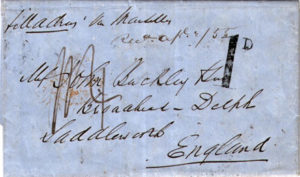
Fig 1. Sydney 27 Jan 1855 per Madras via Marseilles. The P&O ss Madras left Sydney on 27 Jan 1857, the only P&O voyage during the accountancy period. Letter sent unpaid, 1/4d collect, being 6d packet plus 10d due to France for a letter between ¼ and ½ oz. NSW claimed 1d for inland NSW postage. Back stamped at Manchester 1 Apr.
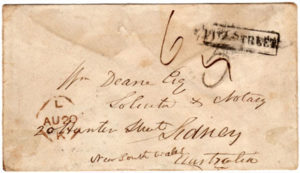
Fig 2. 1856. London to Sydney unpaid. By the White Star clipper White Star, 77 days to Melbourne, the third fastest outbound voyage in 1856, and on to Sydney by the coastal steamer Yarra Yarra. UK stated its claim to 5d with the hand stamp partly obscured under the London street marking, and Sydney charged the recipient 6d. Back stamped Sydney 10 Nov.
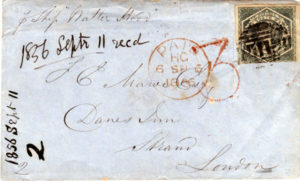
Fig 3. 1856. Sydney to London per ship Walter Hood. She belonged to the Aberdeen White Star Line and was not a contract packet. Fully prepaid 6d, Sydney accounted 3d to the UK by the red hand stamp, and London marked the letter as PAID on arrival. Back stamped Sydney 1 Jun.
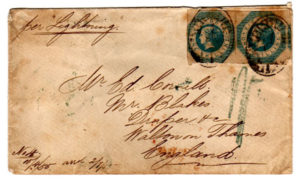
Fig 4. Apr 1855. Melbourne to UK by the world-famous clipper Lightning; she still holds the record for a big sailing ship from Melbourne to Liverpool – 64 days – but not this voyage – still a respectable 79 days. A double rate letter sent during the “retaliatory” period, prepaid 2 shillings at Melbourne and charged 2 x 6d packet rate on arrival Liverpool with the stylised “1/-“ marking in green ink. Back stamped with the UNPAID version of the Liverpool Australian Packet marking type P28.
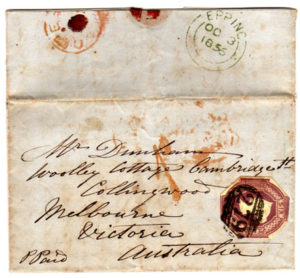
Fig 5. Oct 1856. UK to Melbourne on the last outbound clipper packet mail. Carried by the Black Ball Line’s Donald McKay from Liverpool 5 Oct, arrived Melbourne 28 Dec on a slowish passage of 84 days, slightly delayed by having to put into Cork owing to the death of her surgeon. These ships carried hundreds of emigrants and a surgeon was required by the Board of Trade. Prepaid 6d, 1d red accountancy mark for the sum due to Victoria, the retaliatory rate period now being over.
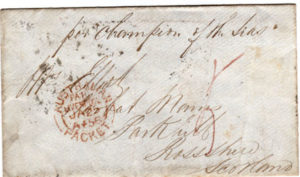
Fig 6. Oct 1855. Victoria to Scotland per Champion of the Seas. Prepaid 6d in cash, of which 5d to UK in red manuscript, as she was a British packet. The first Black Ball contract, of which this is an example, specified a return voyage as a packet; for the second contract the owner, James Baines, refused to undertake a return mail contract to fixed dates so Victoria chartered ships on a single voyage basis as opportunity offered. See Fig 7.
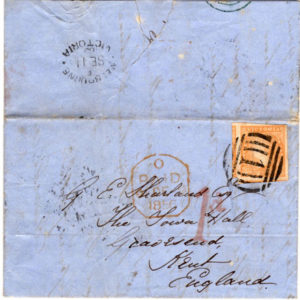
Fig 7. Sep 1856. Melbourne to UK. Carried by the sailing ship True Briton on a single-voyage contract with the Victoria Post Office. 6d prepaid, 1d due to the UK in red for inland postage. 87 day passage arriving Gravesend on 8 Dec.
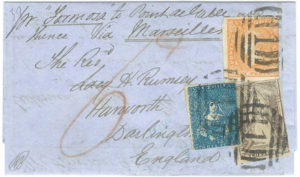
Fig 8. (Courtesy of John Barwis, USA). This is the only recorded Half-Length cover sent at the 11d rate via Marseilles (under ¼ oz). Formosa was contracted by Victoria to carry a mail to Galle, thence to UK per P&O, arriving Southampton 17 Oct and London via Marseilles on 13 Oct. The “6” in manuscript is 6d due to the UK, being 1d UK inland on a colonial packet, and 5d due to France for transit fees – the 5d was paid by the UK under the Anglo-French postal treaty. Melbourne backstamp 28 July 56, Darlington 14 October 56. No other markings are present other than the manuscript 6d on the front.
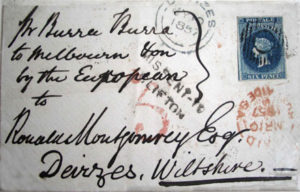
Fig 9. (Courtesy of Pat Grimwood-Taylor). Prepaid 6d with a 5d accountancy marking. This cover went per European from Melbourne 15 March, arriving Southampton 8 May per Etna. This was the last attempt by South Australia to continue with the old accountancy system that I have seen for packet mail.
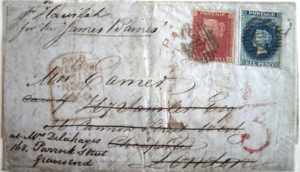
Fig 10. (Courtesy of Pat Grimwood-Taylor). This cover demonstrates in spectacular style that every voyage during the accountancy period has to be very carefully analysed. On this occasion the Black Ball Line’s James Baines left Melbourne on 8 Aug 1856 under contract as a packet to the Post Office of Victoria, arriving at Liverpool on 21 Nov. Letters from Victoria were treated as packet letters, and accounted for as such, but this cover from South Australia was accounted for as a ship letter, and so marked by Liverpool, with its status confirmed by the 3d accountancy marking. The 1d red adhesive applied for the redirection fee adds to its attraction.
GPO Notice 56 of 1854
Tabeart, Colin Australia New Zealand UK mails to 1880; Rates Routes and Ships Out and Home; the Author, Fareham, 2004, ISBN 0-9548407-0-4; p 8
The European & Australian Royal Mail Co
GPO Notice 73/1856. The contract steamers referred to were those of the European and Australian Royal Mail Company.
Victoria Govt Gazette CO312/4
The harbour for Albany, Western Australia
See the author’s Robertson Revisited
It was difficult to get a decent return cargo in a hurry; also it was difficult to retain a crew once the ship docked – many deserted for the gold fields or other reasons.

